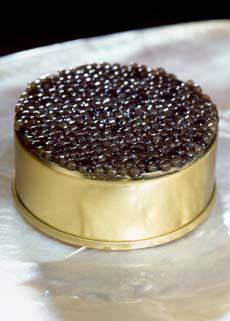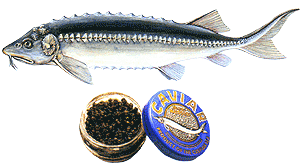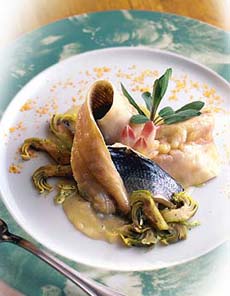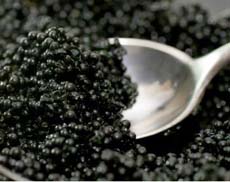

Beluga caviar from the Caspian Sea is no longer available in the U.S., because the fish is on the Endangered Species List. Photo courtesy CaviarRusse.com.
May 2005
Last Updated May 2017
|
 |
Caviar Glossary
Page 2: Black Caviar, Beluga Caviar & Other Terms With B
This is Page 2 of a ten-page glossary. If you’d like to suggest additional words for inclusion, or think we should consider other definitions than those we have provided, use the Contact Us link on this page. You may also enjoy our many other food glossaries.
Click on a letter to go to the appropriate glossary page.
a b c d e f g h i j k l m n o p q r s t u v w x y z
This material is copyrighted and cannot be reproduced in whole or in part
without written permission.
|
BAERII CAVIAR & STURGEON
The Siberian sturgeon, Acipenser baerii, swims wild in China, Russia and Kazakhstan. Due to overfishing, the Baerii is on the World Wildlife Foundation’s Endangered Species List as “Vulnerable.” The Baerii (pronounced BAY-air-ee) is being farmed successfully in France, Uruguay and elsewhere, is said to be the closest caviar to its Caspian cousin, osetra (Acipencer gueldenstati). Baerii is often sold as osetra—but it isn’t, any more than a Macintosh apple is a Granny Smith. Baerii caviar can be harvested at 6 to 9 years of age or younger, compared to 12-15 years for the osetra.
|
|

Farmed Baerii caviar from The Little Pearl,
a NIBBLE Top Pick Of The Week
|
The baerii sturgeon is significantly smaller in size (33 to 44 pounds compared to 440 pounds for a female osetra). It is faster to reproduce, which makes it less complex; it does not have intramuscular fat, which adds flavor. See also naccarii sturgeon.
BEADS
The caviar eggs are called beads or pearls in the trade.
BELUGA CAVIAR
The largest species of sturgeon, the white Beluga (genus and species: Huso huso—“beluga” means white in Russian) can grow up to 30 feet long and weigh up to 3,300 pounds. The beluga is a predator: it feeds on smaller fish. Up to 15% of its body weight can be roe (see photo of roe at top of page). Despite that, the caviar is rare: the species is not plentiful and the female does not mature to produce roe for 18 to 20 years (although it can live for 100 years).
|
Its scarcity makes it the most expensive caviar. Its eggs are also the most fragile. Harvested from Caspian Sea fisheries in Russia and Iran and Black Sea fisheries in Russia and Romania, the large eggs (3mm to 4mm diameter) are soft in texture, heavy and ripe, and range from pale silver to pearl gray to black in color.
|
|

The beluga sturgeon can grow to 30 feet and 3,000 pounds. Photo courtesy VictoriaPackaging.com.
|
The taste is soft, buttery and delicate. Beluga is graded 000 for the lightest silvery gray, to 0 for the blackest (although color is purely aesthetic and has no bearing on taste). While Beluga is the most expensive and thus most prestigious caviar, many connoisseurs find it too bland and delicate and prefer the nuttier Osetra. Beluga is always packaged with a blue lid (see photo above).
While the U.S. banned import of Caspian caviar (beluga, osetra and sevruga) in October 2005 because the fish are on the Endangered Species List, the Convention on International Trade in Endangered Species told ten nations that actively export caviar to halt export. Iran, which has maintained better conservation of its waters and better legal practices (i.e., control over poachers) still exports its caviar. For more information, click here.
|
BESTER CAVIAR
A new, farm-raised American caviar from a sturgeon cross-breeding of a female Beluga (Huso huso) and a male Sterlet (Acipenser ruthenus) from the Caspian Sea. This caviar is said to look and taste very similar to Beluga. The eggs are medium size and range in color from light gray to black; the taste is said to be wonderfully delicate. If this is true, at $70 an ounce it’s a great caviar bargain, as Beluga is unavailable at any price in the U.S. (and would probably be three times that price if it were).
|
|

Does Bester caviar really taste like Beluga? We’ll have to get some to find out! Available at CaviarStar.com. |
|
BLACK CAVIAR
A generic term, originally referring to Caspian caviar (beluga, osetra, sevruga) but now referring to any black roe. Some roes are dyed black to make them more appealing.
BLACK PEARL
An endearing term given by some to sturgeon caviar. It compares the caviar to extremely rare black Tahitian pearls.
|
|

From Prunier restaurant in Paris, the Christian Dior Egg: a sautéed scallop in aspic with osetra caviar crown. It was a favorite of the designer Christian Dior, and is named in his honor.
|
|
BLACK SEA
Like the Caspian Sea, the Black Sea is an inland sea bordered by numerous countries: Bulgaria, Georgia, Romania, Russia, Turkey and Ukraine. Another home to the Beluga sturgeon, it is slightly larger than the Caspian, with a surface area of 168,495 square miles, but somewhat shallower, with a maximum depth of 2,206. As with the Caspian, damming, overfishing and pollution have driven the sturgeon to near extinction.
|
|

The Black Sea and its neighbors. Photo courtesy Wikimedia Commons. |
|
BLINI or BLIN
Small, thin, yeast-raised buckwheat pancakes, usually served with caviar, smoked salmon, and crème fraîche or sour cream. The Russians originally created blini with buckwheat specifically to complement the flavors of Caspian caviar, but they are wonderful with salmon caviar as well and can be served in any way you’d enjoy a pancake. Caviar can be rolled or folded in large blini (4" diameter) or eaten like canapes on small blini (2" diameter).
|
|

Blini with three caviars. Photo courtesy of Petrossian.com. |
|
BOTTARGA
A specialty of southern Italy once referred to as “poor man’s caviar,” bottarga is the salted, pressed and dried roe of tuna (it also can be made from mullet). After the roe is harvested, it is then salted and massaged by hand for several weeks; then pressed and sun dried for up to two months. Bottarga has a salty flavor that reminds one instantly of the sea. It is grated, and a little can goes a long way. A traditional use is to sprinkle some grated bottarga over spaghetti and toss with olive oil and red pepper flakes. It is also used as a bread topping, salad ingredient and in rice dishes.
|
|

Bottarga pressed and grated; sprinkle it as a tasty garnish. Bottarga available from GourmetSardinia.com. |
BOWFIN CAVIAR
The bowfin, also called swampfish, mudfish, cypress trout, and by the Cajun name “choupique,” is an ancient fish that that is more than 180 million years old. Its botanical name is Amia calva, and it is not in any way related to the sturgeon, another ancient fish. The two fish diverge after the phylum level, which is as far apart as you can get in Animalia (animal) taxonomy.
|
|

Bowfin caviar, called “choupique” in Cajun. Photo courtesy Apilcina.com. |
In the American South Bowfin was long discarded as a “trash fish,” the flesh used in fish cakes. It has come to prominence since the ban of imported Caspian caviar, as caviar lovers seek new types of roe. Bowfin roe is called “Cajun caviar” in some parts of the South. The roe is glistening black like sturgeon caviar, firm, and very flavorful.
Continue To Next Page: Caviar Terms With C
Go To The Article Index Above
Lifestyle Direct, Inc. All rights reserved. Images are the copyright of their individual owners.

|












